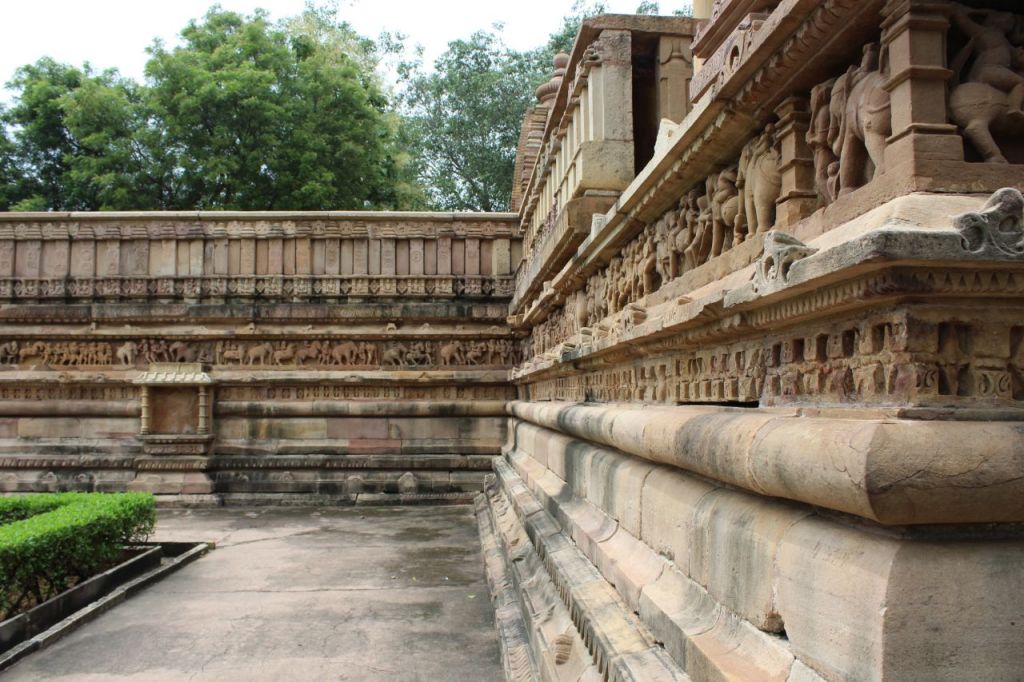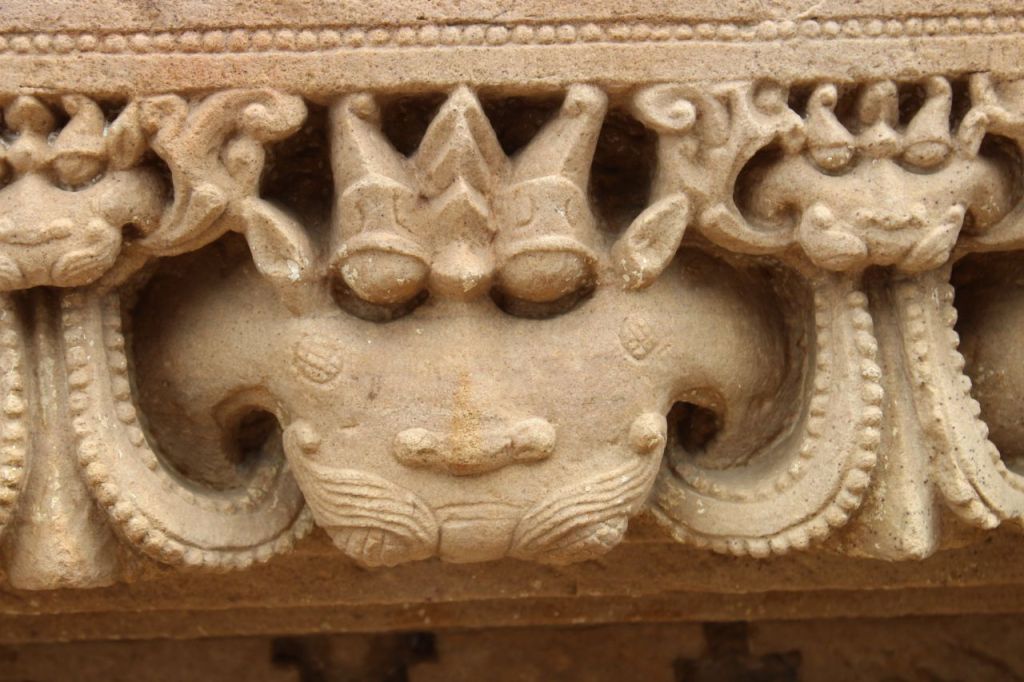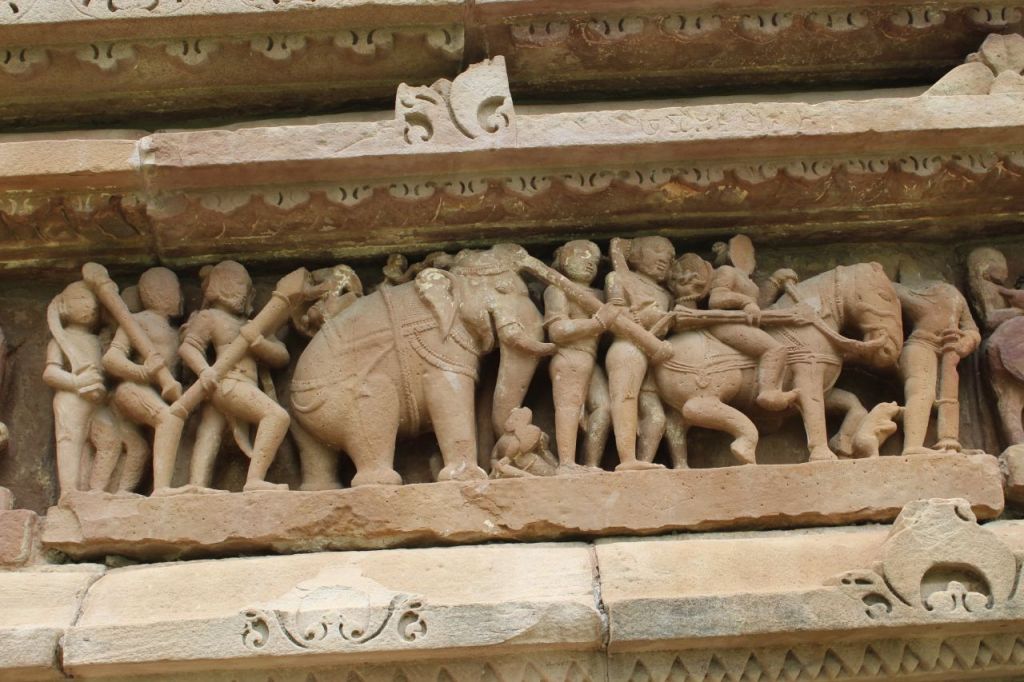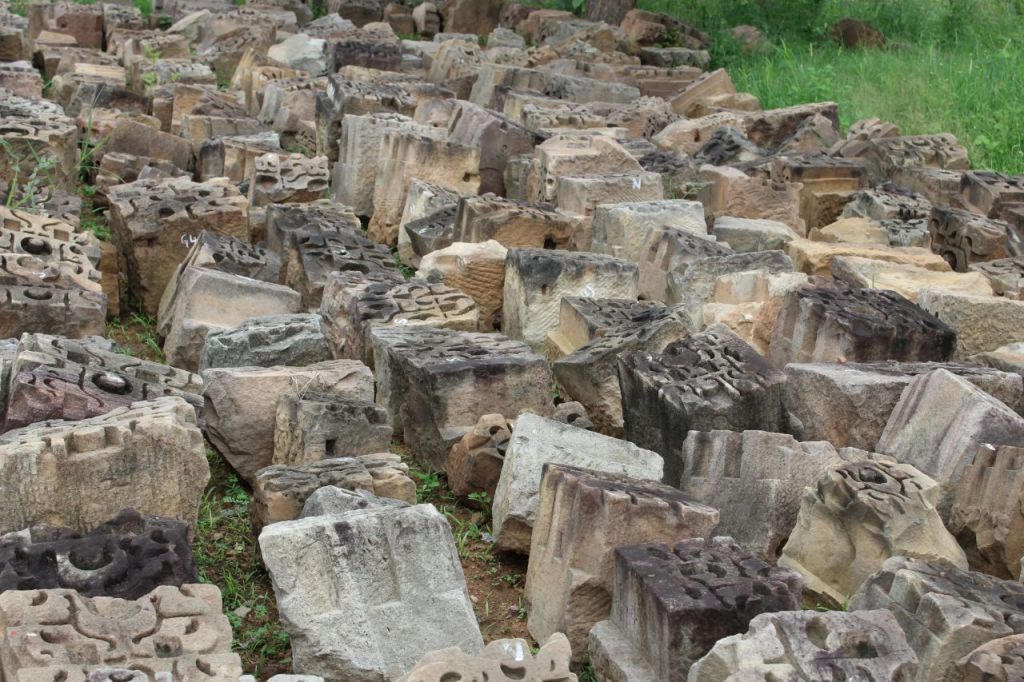The “Khajuraho Group of Monuments”, a UNESCO World heritage site is famous for it’s magnificent medieval creations and legacy left by Chandela rulers. Time and again, the sculptures in Khajuraho temples have raised a lot of eyebrows, garnered notoriety and curiosity alike. The streets of this small town are flooded with erotic themed creations, artifacts and literature on display as tourist attractions. But there’s much more to it than what meets the eye. Do not rush to judge or draw a conclusion until experienced at your own pace.
The Sculptures
Many researchers, scholars and historians have presented their understanding and theories about the nature of these sculptures. The original idea behind the construction of initial Khajuraho temples dates back to King Chandravarman as a tribute to his mother. He was moved by her tale (Refer to History of Khajuraho Temples) and wanted the wall art to portray human passions in its true and purest forms, not as a sin. Chaturbhuj temple is the only exception with no erotic art on display.
Some interpretations highlight these carvings as a way to impart sex education among masses, a taboo subject till date. It is an example of the brilliance with which this knowledge has been imparted in a visible format (a common feature in many Hindu temples in India) without embarrassment. Their presence on the holy temple walls indicates the importance of sexual activity as a sacred form of creating future generations.
Contradictory, another interpretation states that in accord with the Hindu philosophy; one should go through all the four worldly stages of – Dharma, Artha, Kama and Moksha leading to Nirvana. To enter a temple for worship, the desires and lust should be left outside. This explains why none of the carvings of couples in love (termed Mithunas) can be found inside and is limited to the outer walls.
The caretaker at one of the Southern group of temples has the most logical and practical explanation. He mentioned how with the rise of Buddhism, people were inclined to explore a new way of life. It became a common practice to leave their homes and embrace Vairagya in search of Nirvana (or Moksha) – a state of detachment from worldly desires. The rulers, worried, instructed their sculptors to include symbolic structures with scenes of domestic life and passion on the temple walls hoping it would rekindle the desires of an ascetic mind.
Last but not the least, research also point towards the Tantric cults and beliefs – predominantly in the Chausath Yogini temple. Some consider it as a Tantric temple in essence with the 64 yoginis combining forces to balance the existence of life. To them, the Mithunas (couples expressing love) are a symbolic representation of the union of Shiva and Shakti.
One or many of these interpretations stated above might be the exact reason behind these creations. Interestingly, the erotic sculptures on the temples constitute a mere 10-15% of the total architecture and eventually became the sole reason of their rising popularity.
What if these images come alive and could speak for themselves with no room for our imagination 🙂





What not to miss in Khajuraho?
Light and Sound show – After a day tour of the “Khajuraho Group of monuments”, be back on time to attend the Light & Sound show conducted in the “Western Group of Temples” premises. The show is conducted every evening in two languages – Hindi & English for duration of approx 45 minutes each. The mesmerizing voice of none other than Mr Amitabh Bachchan (narrator) will import you back in time through the rich legacy and heritage of Khajuraho. Against the backdrop of Indian Classical music and Technicolor floodlights, the temples come alive reminiscing the history, significance and details of each in the order they were built. NOTE: There is an entry fee and photography is prohibited during the show.
Museums in Khajuraho – Three main museums in Khajuraho (Timing: 08:00 AM to 5:00 PM) are considered as tourist attractions. The most important is Archaeological museum (maintained by ASI) near the Western group of temples. The museum entry ticket remains the same one as for these temples. It has a small area with a historic collection of sculptures from excavation. Notably, it also houses the sole survivors from Chausath Yogini temple – namely Brahmani, Hingalaja (Mahishamardini) and Maheswari. Most of them and artifacts were being shifted to a new and larger museum complex (in 2017 during our visit). Nearby, lies the State Museum of Tribal and Folk Art in the Chandela Cultural Complex. It gives an insight into the customs and rituals of tribal people of Madhya Pradesh showcasing the folk traditions. The Jain museum (named Sahu Shantiprasad Jain Kala Sangrahalaya) is located in the Eastern group of temples. It houses huge statues of Jain tirthankars, Jain scriptures and carvings of their teachings.
Sunrise from Western Group of Temples – Most temples have been constructed per Vaastu Shastra with their deities facing east and thus the first sun rays directly fall on the feet of main deity in the sanctum. Even if you miss this spectacle, the divinity of the beautiful sunrise would remain a life time experience – unlike any.
Khajuraho Dance Festival – The month of February is a time of festivity in this quaint town. Annually, the Madhya Pradesh Kala Parishad organizes the world renowned “Khajuraho Dance Festival” – a celebration of art and culture. The open air auditorium in the Western Group of temple’s complex sets the stage for a week – with Chitragupta and Vishwanath temple as the main backdrop. Predominant personalities from the fields of Indian Classical dance styles – Kathak, Bharatnatyam, Odissi, Kuchipudi, Kathkali, Manipuri and recently from other modern Indian dance forms grace the occasion with their talent. Perhaps, the tourist season is at peak during this time of the year with many westerners attending this cultural extravaganza.
The temples and ruins of Khajuraho are intriguing and mysterious, standing tall with exemplary beauty. Keeping pace with the needs of changing times, they still hold secrets to an era gone by. Mere sightseeing might not take more than two days at maximum; however, if travel is about breaking stereotypes and understand a place in it’s core essence – Khajuraho would be the finest example.
More from Khajuraho in pictures:



**Images used in the article are courtesy Suchita Roy.
Online research (for technical details and historical facts) with stories/inputs from locals as gathered during our visit finally resulted in this write-up. For any further queries, feel free to leave a comment below or email. I will revert at the earliest.
Related Post: Exploring the Temple Town of “Khajuraho” (Part – 1)

Leave a reply to Deepika Cancel reply